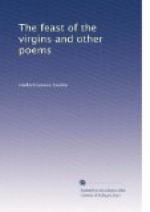March—Ista-wee-ca-ya-zang-wee—the sore-eyes moon (from snow blindness).
April—Maga-oka-da-wee—the moon when the geese lay eggs; also called Woka da-wee—egg-moon; and sometimes Wato-papee-wee, the canoe-moon, or moon when the streams become free from ice.
May—Wo-zu-pee-wee—the planting moon.
June—Wazu-ste-ca-sa-wee—the strawberry moon.
July—Wa-sun-pa-wee—the moon when the geese shed their feathers, also called Chang-pa-sapa-wee—Choke-Cherry moon, and sometimes—Mna-rcha-rcha-wee—“The moon of the red-blooming lilies,” literally, the red-lily moon.
August—Wasu-ton-wee—the ripe moon, i.e., Harvest Moon.
September—Psin-na-ke-tu-wee—the ripe rice moon. (When the wild rice is ripe.)
October—Wa-zu-pee-wee or Wee-wa-zu-pee—the moon when wild rice is gathered and laid up for winter.
November—Ta-kee-yu-hra-wee—the deer-rutting moon.
December—Ta-he-cha-psung-wee—the moon when deer shed their horns.
[72] Oonk-to-mee—is a bad spirit in the form of a monstrous black spider. He inhabits fens and marshes and lies in wait for his prey. At night he often lights a torch (evidently the ignis fatuus or Jack-o’ lantern) and swings it on the marshes to decoy the unwary into his toils.
[73] The Dakotas have their stone-idol, or god, called Toon-kan—or Inyan. This god dwells in stone or rocks and is, they say, the oldest god of all—he is grandfather of all living things. I think, however, that the stone is merely the symbol of the everlasting, all-pervading, invisible Ta-ku Wa-kan—the essence of all life,—pervading all nature, animate and inanimate. The Rev. S.R. Riggs, who for forty years has been a student of Dakota customs, superstitions, etc., says, Tahkoo Wahkan, p. 55, et seq.: “The religious faith of the Dakota is not in his gods as such. It is in an intangible, mysterious something of which they are only the embodiment, and that in such measure and degree as may accord with the individual fancy of the worshiper. Each one will worship some of these divinities, and neglect or despise others, but the great object of all their worship, whatever its chosen medium, is the Ta-koo Wa-kan, which is the supernatural and mysterious. No one term can express the full meaning of the Dakota’s Wakan. It comprehends all mystery, secret power and divinity. Awe and reverence are its due, and it is as unlimited in manifestation as it is in idea. All life is Wakan; so also is everything which exhibits power, whether in action, as the winds and drifting clouds; or in passive endurance, as the boulder by the wayside. For even the commonest sticks and stones have a spiritual essence which must be reverenced as a manifestation of the all-pervading, mysterious power that fills the universe.”
[74] Wazi-kute—Wah-ze-koo-tay; literally—Pine-shooter,—he that shoots among the pines. When Father Hennepin was at Mille Lacs in 1679-80, Wazi-kute was the head chief (Itancan) of the band of Isantees. Hennepin writes the name Ouasicoude, and translates it—the “Pierced Pine.” See Shea’s Hennepin, p. 234, Minn. Hist. Coll. vol. i, p. 316.




